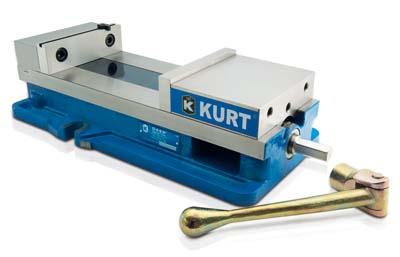
Kurt Manufacturing Co.'s D688 vise has an 8.8-inch jaw opening and repeatability to within 0.001 inch. It produces up to 7,968 lbs. clamping force with just 80 ft. lbs. input torque. Designed for the high performance requirements of the latest machining centers, the D688 meets the needs of today's highly skilled and demanding machinists, reports Steve Kane, Global Sales and Marketing Manager for Kurt Industrial Products. Designed with high precision roller bearings and alloy steel screw mechanism, D688 vises distribute clamping force evenly and precisely across the full jaw surface. The Anglock design in the movable jaw (patented by Kurt) further reduces jaw lift. Providing overall vise rigidity while absorbing machining vibration, Kurt D688 vises have porosity-free, 80,000-PSI ductile iron bodies. Additional features include removable, hardened jaw plates, ergonomically designed vise handle, and GrooveLock workstops that store easily in the vise body. The D688 vise is designed for use on the latest machine tools including machining centers and knee-type mills. The D688 is ideal for all types of machining operations including precision boring, tapping, drilling and finishing with high accuracy on most part configurations.
Contact Details
Related Glossary Terms
- boring
boring
Enlarging a hole that already has been drilled or cored. Generally, it is an operation of truing the previously drilled hole with a single-point, lathe-type tool. Boring is essentially internal turning, in that usually a single-point cutting tool forms the internal shape. Some tools are available with two cutting edges to balance cutting forces.
- centers
centers
Cone-shaped pins that support a workpiece by one or two ends during machining. The centers fit into holes drilled in the workpiece ends. Centers that turn with the workpiece are called “live” centers; those that do not are called “dead” centers.
- tapping
tapping
Machining operation in which a tap, with teeth on its periphery, cuts internal threads in a predrilled hole having a smaller diameter than the tap diameter. Threads are formed by a combined rotary and axial-relative motion between tap and workpiece. See tap.

